6. Moving Servos
Servos are used for high-precision movement of robot arm joints, camera gimbals, and more. This tutorial will provide technical information about servo motors and how they work. We made it easy to get a robot up and running. However, there are many fun and exciting things to learn about how the robot works. The more you know, the more you can get your robot to do it!
Types of Servos
ARC supports all servos, including the ability to define your servo driver using the Servo Script Robot Skill. The most common types of servos are...
- PWM Hobby servos that are connected directly to EZB digital ports
- Serial Smart Servos (Robotis Dynamixel, Lynx Motion, Feetech, Kondo KRS, LewanSoul, UB-Tech, and more)
- PWM servo extenders (SSC-32)
*Note: You will find servo driver robot skills in the Servo Robot Skill Category. These skills are also listed at the bottom of this document.
Servo Interface Menu
ARC displays a standard configuration dialog for configuring servos across all robot skills. This manual will explain how to configure a servo (even multiple servos) to be moved from a robot skill. In this example, we will use a vertical servo robot skill, although this procedure applies to any robot skill that uses servos. Many robot skills use servos, including WiiMote, MYO, Camera, and dozens more...
The standard servo interface menu is the same across all robot skills that use servos. This menu will be displayed when selecting a servo in a robot skill's configuration. You can choose the port, EZB Index, the MIN position value, and the MAX position value of each servo. You may also select the checkbox to invert the direction.
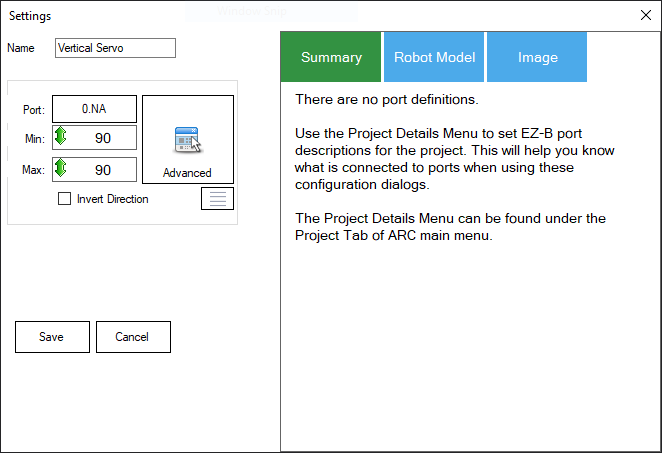
Advanced Servo Interface Menu
This new menu will display when the advanced button is pressed on the standard interface menu. This advanced menu allows specifying additional options and adding multiple servos. The advanced interface is also used when configuring acceleration, velocity, or speed of servos that support those properties.

*Note: Hover your mouse cursor over the blue question marks to read about advanced options. Many advanced options require hardware support to work. So, by default, they are set to -1, which means ignore.
Specify Servo Resolution
By default, the software will have a servo resolution of 180 positions. While most hobby servo controllers (i.e., Arduino, EZ-Robot EZB) are limited to 180 degrees, some servos support a much higher resolution (i.e., Dynamixel). You can configure ARC to support a higher servo resolution per project. The global servo resolution setting can be configured in the My Robot Project Properties menu. The range will be calculated to compensate if the value of servo positions is higher than the EZB supports. For example, if you set the ARC servo resolution to 360 while using an EZ-Robot EZB v4, the value of 360 will become the new maximum servo position.
*Note: The maximum number of servo positions ARC supports is 2,147,483,647
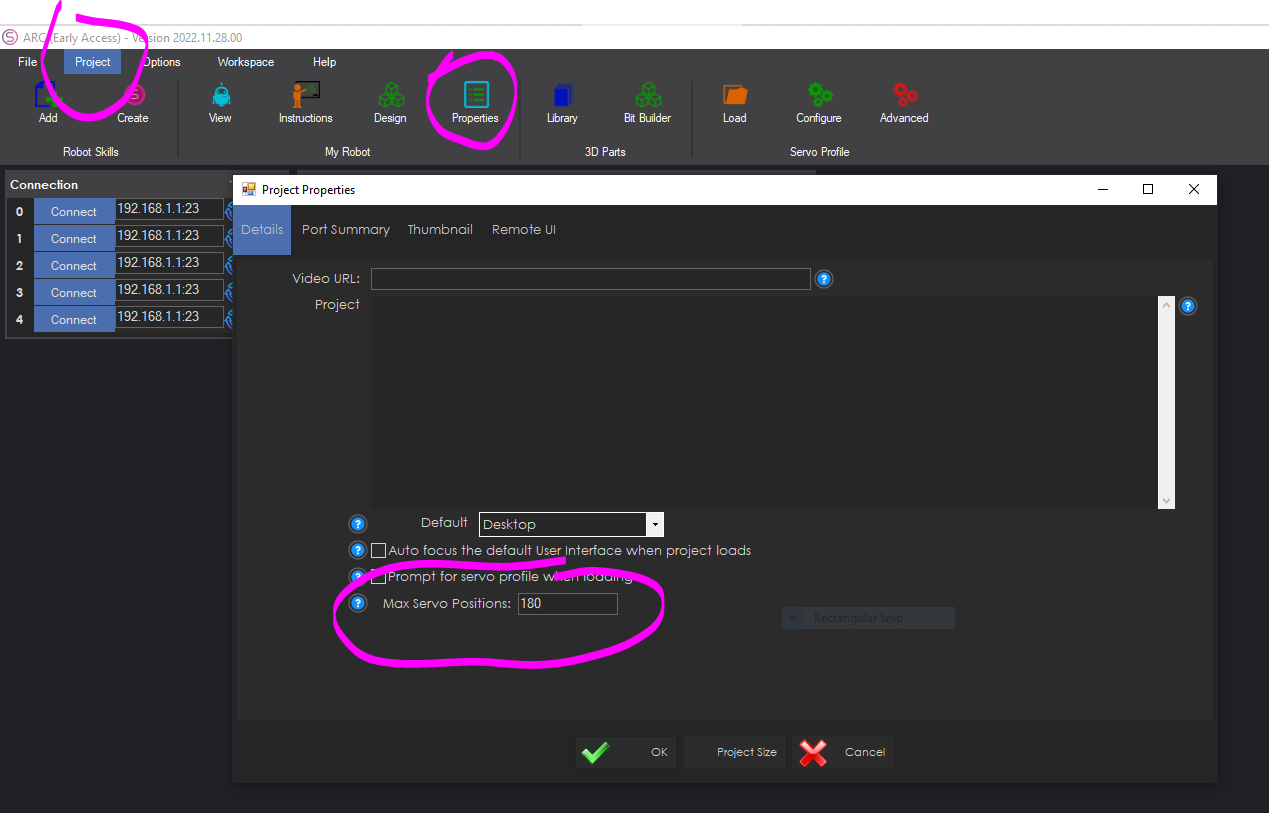
Most Popular Servo Robot Skills
There are many robot skills control servos, such as the Camera Device, WiiMote, Joystick, and scripting, to name a few. There are a few of the most popular servo skills used by robot builders to get started.
Vertical/Horizontal Servo
Great for testing and moving your first servo! These robot skills are excellent for testing your robot's movement range and ensuring the servos work. We always recommend using these robot skills when building your robot to ensure everything works correctly. At the same time, the two versions of this skill differ in how the user interface is presented by dragging vertically or horizontally. This does not have to matter based on the orientation of your servo in the robot itself. These two skills can be used for testing as it is a matter of preference.
 Horizontal Robot Skill
Horizontal Robot Skill
 Horizontal Robot Skill
Horizontal Robot Skill

One of the most powerful and popular robot skills demonstrating ARC's power is the Camera Device. This robot skill will use either the EZB remote camera (if supported) or a USB webcam mounted on the robot. By configuring options, you can have the camera track objects, faces, and colors and even detect emotion or age with additional robot skills. The Camera Device has settings in the options menu for controlling servos when a camera is mounted on a gimbal. This feature allows the robot's camera to move and track the object.
 Camera Device
Camera Device

Create servo animations to have your robot wave, dance, or pick up and move objects. The Auto Position skill transforms a group of servos into custom positions (Frames) to create animations. You can combine the frames into actions for your robot's animation. This is done with "Inverse Kinematics" or "Motion Planning."
There are two types of the Auto Position robot skill. One is a movement panel that plays servo animations for robots that use servos to walk (i.e., humanoids or hexapods). The other type is used for robots that use a different movement panel (i.e., hbridge, continuous rotation, etc.) but has servos for arms to be animated.
This is a popular robot skill for humanoid robots, such as the InMoov, Robotis Bioloid, or EZ-Robot JD/Six. For robots with many servos used in arms or legs, this allows creating animations that can be executed programmatically by other robot skills using the ControlCommand(). This means your robot can perform actions based on speech recognition or chatbot conversations.
 Auto Position with movement panel
Auto Position with movement panel
 Auto Position for only servos
Auto Position for only servos

There are two types of joystick robot skills based on the type of joystick used. The most common type is the XInput version, which supports the latest joysticks, including Xbox controllers. The xInput has additional support for analog trigger buttons and multiple independent joysticks. These robot skills can control servos, allow scripts to be assigned to buttons, and optionally control the current movement panel to move the robot.
 Direct Input Joystick
Direct Input Joystick
 xInput Joystick
xInput Joystick

Being able to control your robot servos with your hands and move the robot's camera with your head is a fantastic experience. A few robot skills support a variety of VR headsets, including the Meta Oculus Quest and Steam VR (i.e., HTC Vive, Windows Mixed Reality, etc.). The hand tracking feature is one of the great features of using the Meta Oculus Quest robot skill. This feature lets you move servos without needing to hold the controllers in your hands. You can map your fingers to individual servos, which is excellent for humanoid projects like the InMoov.
 Direct Input Joystick
Direct Input Joystick
 xInput Joystick
xInput Joystick
Hard Set Servo Limits
You can set global servo positions across all robot skills with the appropriate Javascript, EZScript or Python commands.
The robot skill settings for servos are for the individual robot skill only. Every robot skill has servo values (i.e., min and max). This means the Camera skill has different servo values than the Joystick skill. The values specified in a skill's configuration are specific to that skill.
There are commands for all languages (JavaScript, Python, EZ-Script, etc.) for specifying limits. For example, the EZ-Script command in an INIT script to specify servo positions globally across the entire application is...
SetServoMin (servoPort, position)
Set the minimum limit that this servo can ever move to
Servo position is between 1 and 180
Example: SetServoMin(D14, 40)
SetServoMax (servoPort, position)
Set the maximum limit that this servo can ever move to
Servo position is between 1 and 180
Example: SetServoMax(D14, 100)
Here's an example from the EZ-Robot JD project that makes the left gripper not move further in either direction globally across the ARC software. Use the JavaScript, Python, or EZ-Script manual for the appropriate commands for setting global servo position values.
# Left Gripper
SetServoMin(d6, 30)
SetServoMax(d6, 90)
Example Testing a PWM Servo
Because ARC uses a standard dialog for configuring servos, the following steps will demonstrate how to use it. Any robot skill supporting moving servos will display the same "servo selection" dialog as this example. In this example, we will use a standard PWM hobby servo connected to one of the EZB digital ports.
Step 1
Load ARC and connect to an EZB. Add a servo to the D0 port of the EZB.
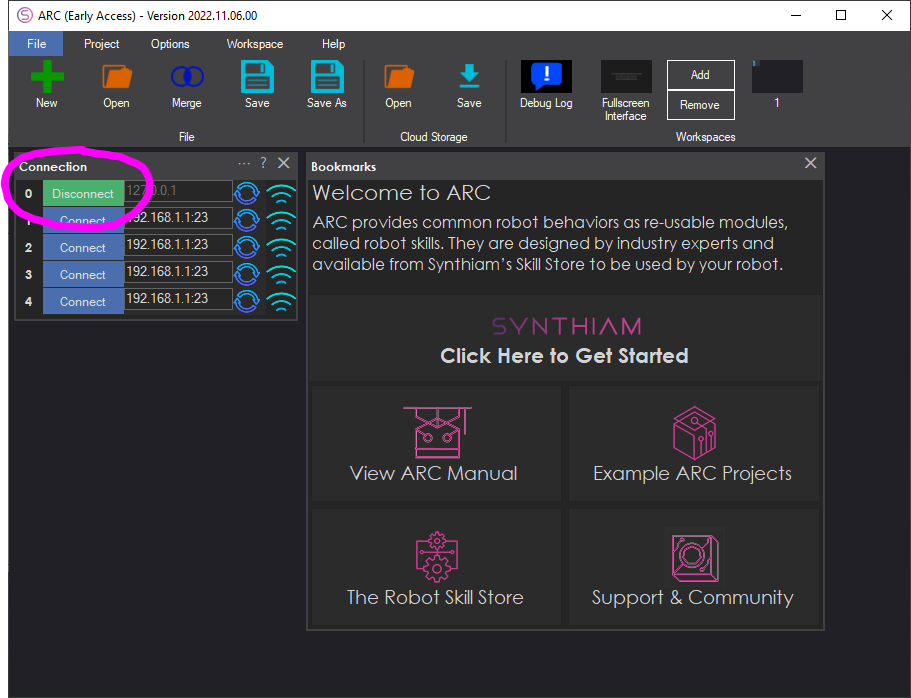
*Note: Ensure you have the latest ARC. When you load ARC with an internet connection, it will notify you if a newer is available.
Step 2
Press the Project tab from the top menu. Now press the Add Control button.
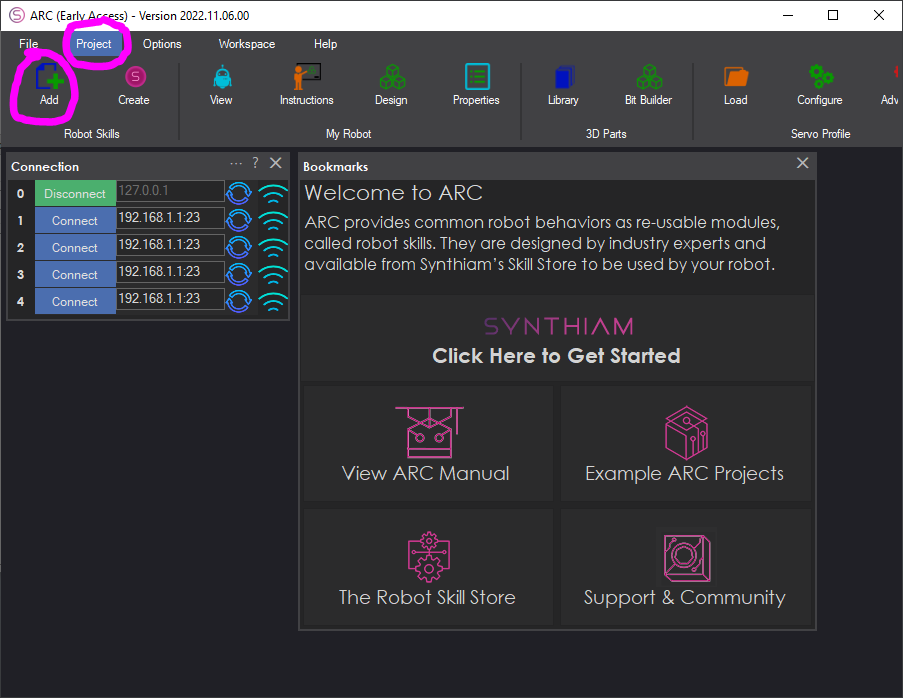
Step 3
The Add Control window will display. This window allows you to browse and select controls to add to your project. Press the SERVO tab to view servo-specific robot skills.
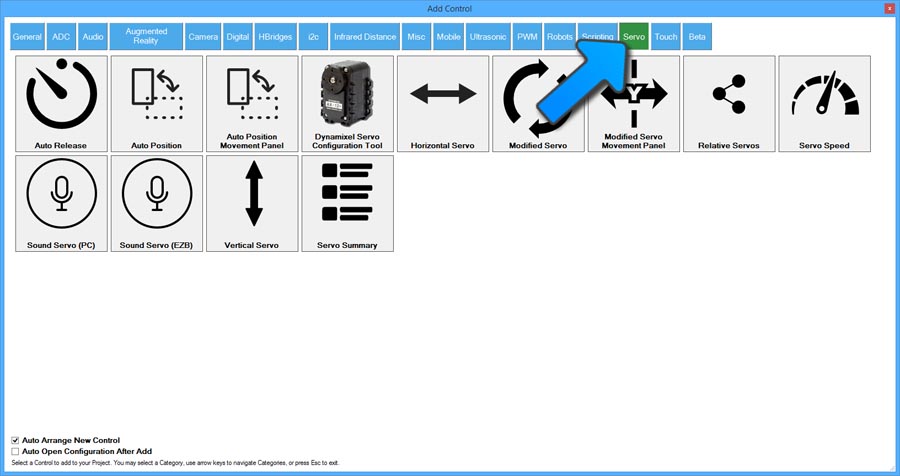
Step 4
We are going to use the Vertical Servo control for this example. Many kinds of robot skills interact with servos, even more than you can see on this page. Nearly every skill control uses servos; however, only the specific servo skill controls are listed on this page. Even the Camera, WiiMote, MYO, and more use servos. Click the Vertical Servo button to add the vertical servo skill control to your project.
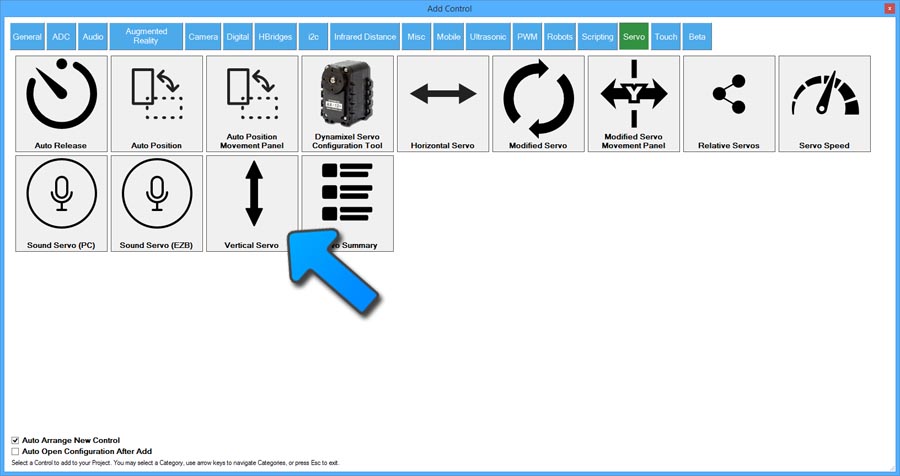
Step 5
You will add the Vertical Servo skill control to the workspace. This skill allows sliding the mouse vertically to move a servo position. Alternatively, a Horizontal Servo skill control enables the mouse to be dragged horizontally to move the position.
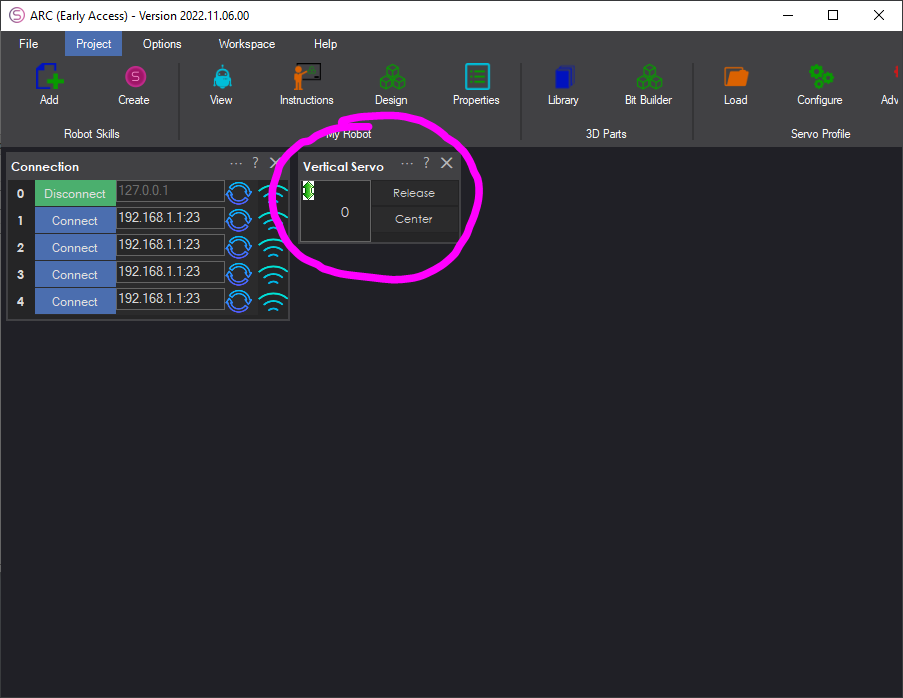
Step 6
As mentioned in the Controls Tutorial, every control has a gear button. You can press this gear button to load the configuration menu. Each control has a unique configuration menu.
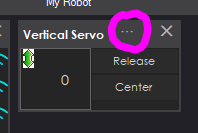
Step 7
ARC will now display the configuration menu
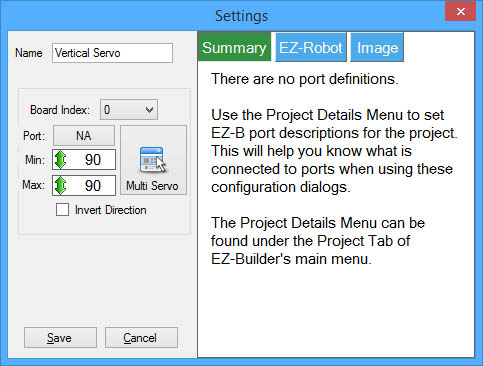
Step 8
Each configuration control will have many options. Any control that uses Servos will have a similar servo configuration interface. Some controls may have two or more servo configuration interfaces (usually for horizontal and vertical servo control). In this control, there is only one servo interface.
Name: This is the name of the control.
Board Index: ARC can connect 5 EZ-Bs to the ARC Software. This specifies which EZ-B to send the servo command to.
Port: The EZ-B port of the servo. Pressing this button will display the EZ-B to select the respective port.
Min/Max: Min and Max limits in degrees of the servo. The servo can move between 1 and 180 degrees. The value for Min must be less than the value of Max in all cases, even when Invert is checked.
Invert: If the servo is moving in the wrong direction, checking this box will reverse/invert the direction of the servo.
Multi Servo: If more than one servo moves, you can specify multiple servos.
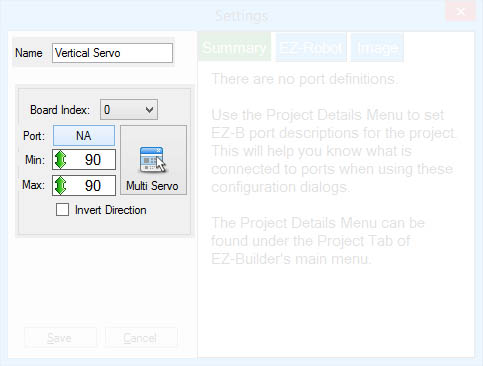
Step 9
Press the PORT button, and ARC will display the EZ-B port configuration. You may select the port and press the Close button in this dialog.
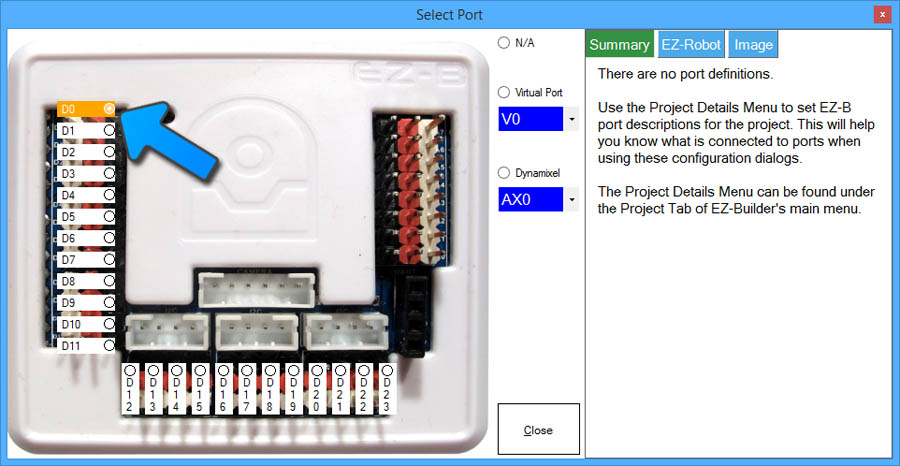
Step 10
Now that you have selected a port, we can move the servo to specify the MIN and MAX limits. These numbers are in degrees between 1 and 180. Start with the MIN by pressing the mouse button while dragging the cursor UP or DOWN. The MIN value must be less than the MAX value. In this example, set the MIN to a low number, and the servo will move in real time if connected to ARC and an EZ-B.
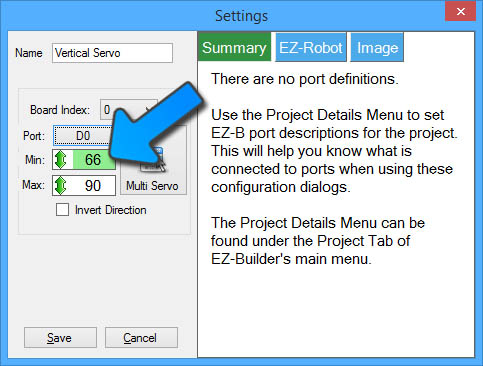
Step 11
Move the MAX by pressing the mouse button while dragging the cursor UP or DOWN. The MIN value must be less than the MAX value. In this example, set the MAX to a low number, and the servo will move in real time if connected to ARC and an EZ-B.
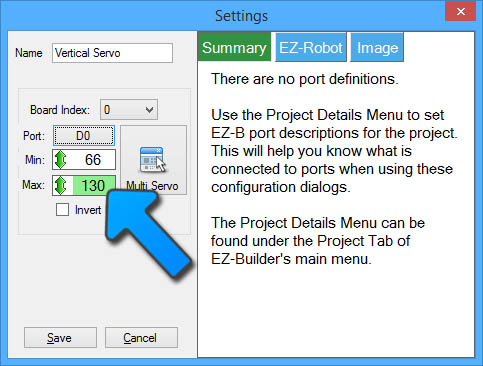
Step 12
If you want this control to move more than one servo simultaneously, the Multi Servo button does just that. Press the button to display the Multi Servo dialog.
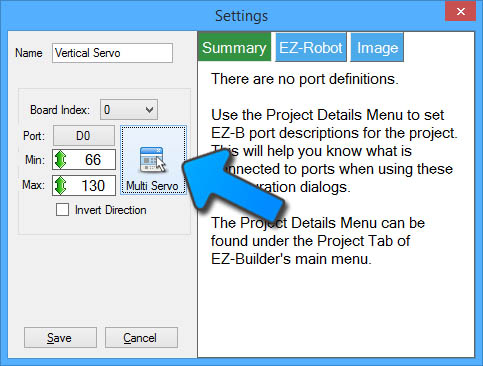
Step 13
To add multiple servos, press the ADD SERVO button. Each time the button is pressed, a new servo entry is added. You can remove the servo by pressing the X on the respective servo. Use the PORT, MIN, and MAX to configure the limits. The multi-servo option also allows a ratio to be specified. The ratio is based on the primary value for the first servo in the list. If the servo degree position for the first servo is defined as ten and the ratio is 2, the respective servo will move to degree position 20.
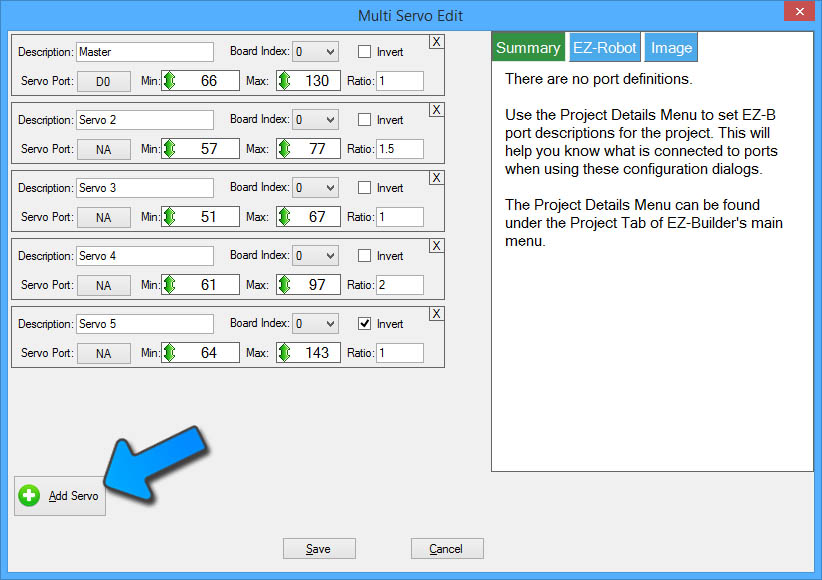
Step 14
Close the configuration dialog for the servo control and return to the workspace. Now that the servo has been configured, you may move it between your specified MIN and MAX limits. Click in the servo position, and the cursor will change while holding the mouse button. Slide the mouse up and down (for vertical control) to move the servo between the specified limits.
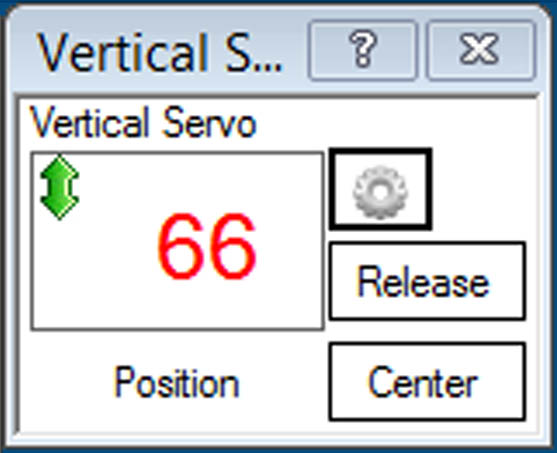
*Note: Even though many controls may move servos, the configuration of those servos is only valid for that control. If you configure a camera control to move servos to specific min/max ranges, those ranges only apply to the camera control. Every control has its own range and settings for versatility.
Servo Robot Skill Drivers
While hundreds of robot skills use servos, that may not be their primary focus, and they are in different categories. For example, the Camera Device is a popular robot skill, but its primary focus is the camera and tracking, so it is located in the Camera category. The Servo category generally lists robot skills that are drivers or servo-specific. You will find the robot skill driver in the Servo category if you use a smart servo, such as the Robotis Dynamnixel. Below is a list of all robot skills from the Servo robot skill category.
Create servo frames and actions to animate gaits and gestures with automatic motion planning, software ramping, movement panel, import/export
Auto-release servos after inactivity: set EZB board/ports, choose 1-60s delay, add/remove ports, pause and view status.
Control a 3-wire continuous 360-degree servo in ARC: adjustable forward/reverse speeds, start/stop buttons, board/port selection and test controls
Control up to 99 servos via Vx virtual ports over serial (Arduino/custom firmware), integrating with ARC for scalable servo management.
Control Robotis Dynamixel XL-320/AX-12/XL430 via ARC virtual servos; supports position, speed, velocity, acceleration, bidirectional UART.
Control Feetech serial-bus servos via EZB UART or PC COM; map ARC virtual ports to IDs; supports position, speed, acceleration, release.
Control Feetech SC series serial-bus servos via EZB UART or PC COM port; map virtual Vx IDs, set position, speed, acceleration, and release in ARC.
Mouse-drag horizontal servo control with configurable min/max limits, center/release functions, multi-servo mirroring and direction invert.
Customizable inverse/forward kinematics editor for robot arms: add joints/bones, map XYZ in cm, auto-calc joint angles for precise 3D positioning.
Control Kondo KRS ICS2/3.5 servos via EZ-B UART; experimental, untested. Supports chaining, virtual servo ports, Release() and Servo() commands.
Control LewanSoul LX-16A servos via ARC: assign virtual ports, read positions, switch servo/continuous modes, and set motion speed/baud.
Compact Lynxmotion Smart Servos with position feedback, safety features and UART TX/RX for Arduino/EZ-B v4; scriptable temp, load, load-dir and ping.
USB control for Pololu Maestro (6/12/18/24) via ARC Vx ports. Maps Vx to Maestro channels; supports position, speed, acceleration, release.
Add ADC positional feedback to hobby PWM servos via minor mod to EZ-B/Arduino; enables real-time position readout, calibration and puppet mirroring
Real-time servo position input via Arduino ADC over I2C; supports Nano (6 channels) or Mega (16), configurable I2C address and scalable chaining.
Synchronize servos by designating a master; slave servos mirror scaled (decimal/negative) positions with min/max limits and pause control
Inverse kinematics for Robotis OpenManipulatorX: compute joint angles and MoveTo 3D (cm) positions, supports camera-to-CM mapping for pick-and-place.
Control a servo with an on-screen mouth widget for interactive positioning and testing.
Drag mouse or finger as a virtual joystick to control pan/tilt x- and y-axis servos with configurable ports, limits, inversion, and backgrounds.
Record, save and replay named servo motion sequences with adjustable speed/direction (-5 to +5), scriptable via ControlCommand() and status variable.
Adjust servo/PWM speed (0-20) between two positions to quickly experiment and tune motion; select board/port; settings aren't saved.
All-in-one servo view showing and editing servo positions and speeds; add servos and resize the control to fit.
ARC integration for SSC-32 servo controllers via PC COM or EZ-B/Arduino UART; maps V0-V31, configurable baud, enables servos in ARC skills.
Control up to 127 stepper motors via Arduinos mapped to ARC servos; supports any stepper driver, serial network, home calibration, speed/accel.
Control UBTECH Alpha UBT-12HC smart servos via ARC using EZ-B v4/IoTiny UART, assign virtual ports, set baud, custom bits and position mapping.
Drag vertically to control a servo within set min/max limits; center, release, invert, and mirror to other servos. For 3-wire GVS servos.
Control Waveshare servos (TTL/RS485): set position & speed, release torque, read position. RTS option for converters; reverse-engineered protocol.
























